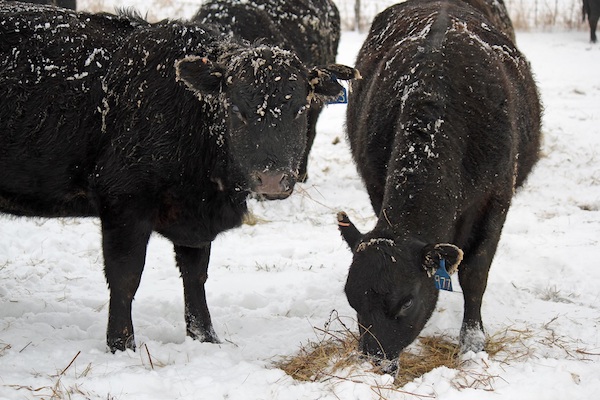Preparing the Cow Herd for Cold Weather
December 2016

Moisture, high winds, and cold temperatures increase the cow's energy requirements.
Cows in an optimal body condition score (BCS 5 to 6) are better able to withstand adverse environmental conditions. As a risk management strategy going into the winter, reduce the number of BCS 4 cows and increase the number of BCS 5 cows in your herd.
Another management strategy is to provide cattle with an area that provides wind protection. The lower critical temperature of a beef cow is the lowest temperature a cow can be exposed to before she needs to have changes metabolically to cope with cold stress.
Usually what happens metabolically is cows begin to shiver. These processes require extra energy. Lower critical temperature for beef cows is influenced by hair coat condition (dry or wet/muddy), body condition (thin, moderate, fleshy) and hair coat description, consisting of summer, fall, or winter.
As hair coat changes from summer to winter, BCS changes from thin to fleshy, and hair coat changes from wet to dry, the lower critical temperature decreases which means cows can withstand harsher conditions without an increase in energy needs. Magnitude of coldness is equal to Lower Critical Temperature - Wind Chill Index. Energy requirement increase about 1% for each degree of cold stress. As an example, cows that have a heavy winter hair coat that is dry and are in condition score of 5 have a lower critical temperature of 19°F.
Energy Needs of the Herd
Let's say, for the next week temperature is going to be 5°F and the wind out of the North at 15 mph, then the wind chill index is -10° F. At those environmental conditions, energy needs of the herd increases by about 30%.
- If the total digestible nutrients (TDN) requirements of the cows are 12 lb of TDN per head per day for this week, you would consider bumping the ration to 15.5 lb/hd/day. This is an increase in 3.5 pounds of TDN per head per day.
- If grass hay is 57% TDN, that's an increase of about 6 lb/hd/day on a dry matter basis.
- If the hay is 88% dry matter, that would mean each cow receives an additional 7 lb/hd/day.
If these cows were being fed 24 lb/hd/day under current conditions, could they eat 31 lb/hd/day during the harsh weather conditions? For a 1200 pound cow, this calculates to about 2.3% of her body weigh on a dry matter basis, - - so yes, the cows could eat the extra feed needed to maintain body condition.
Be very careful if you plan to use grains (corn) to increase the energy density of the diet during severe conditions as you may do more harm than good. Feeding more than 2-3 lb/hd/day of corn to cows on a forage based diet will decrease fiber digestion. When cows are on a forage-based diet and supplemental energy is needed, consider the use of high energy, non-starch feed stuffs such as distillers grains and soy hulls to meet cow energy requirements. It is not advisable to change rations daily, but if is predicted that weather conditions will be severe over a period of time then ration changes may be warranted.
A webinar titled Caring for Cattle in Cold Weather highlights the effects of cold weather on cattle and management practices to help mitigate these effects.
Reference
Rick Rasby, Nebraska Extension
University of Nebraska–Lincoln
back to Cow-Calf, Bull, and Heifer Nutrition